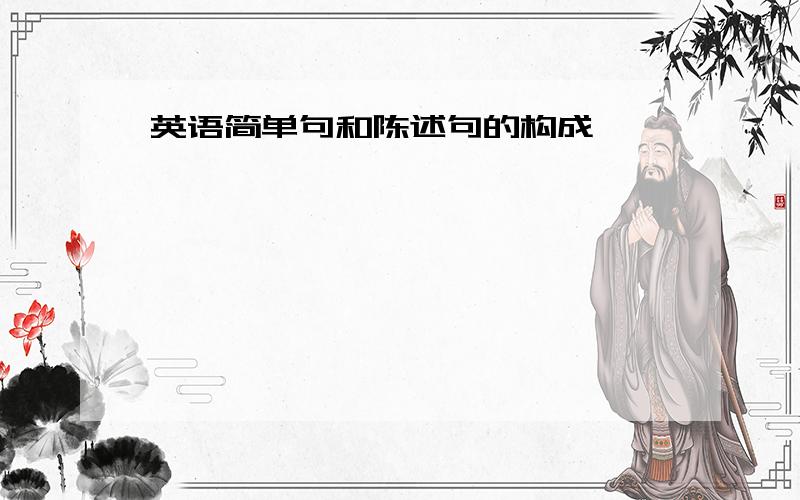英语简单句和陈述句的构成
来源:学生作业帮助网 编辑:作业帮 时间:2024/04/28 23:08:11

英语简单句和陈述句的构成
英语简单句和陈述句的构成
英语简单句和陈述句的构成
英语简单句的构成
1.主语+系动词+表语
系动词和表语一起构成复合谓语
2.主语+谓语
3.主语+谓语+宾语
4.主语+谓语+间接宾语+直接宾语
5.主语+谓语+宾语+宾语补足语
陈述句:分为肯定句和否定句(全否定和半否定)
肯定句:基本结构为主+谓
例如:It is cold in winter.
He went to London to pass his holiday.
否定句:
1、全否定:用not,no,never,neither,none,nothing等否定.表示“完全不是,完全不”的意思.
例如:He is not a worker.
Nothing is wrong with me.
2、半否定句:在句子里用否定词hardly,scarcely,little,few,seldom,rarely等.
例如:I hardly see anything in the room.
=I can see little in the room.
“all/both/every/each/+谓语+not”表示概念为“有的是,有的不是”
例如:All of them are not students.
=Some of them are students,some are not.
3、宾语从句的否定形式:用在think,believe,suppose引导的宾语从句里则否定主句.
例如:I don't think he'll come.
=He will not come in fact,I think.
1 只包含一个主谓结构的句子就叫做简单句 这么简单!
2 陈述句否定式的构成
(1) 如果肯定陈述句的谓语部分含有助动词、情态动词或连系动词be,则只需在这些动词后加not即可构成否定式.
He is playing the guitar.(肯定)
He is not playing the guitar.(否定)
We can get there before dark.(肯定)
We can’t get thee before dark.(否定)
(2) 如果陈述句的谓语动词是实义动词,而其中又没有情态动词或助动词时,则需根据人称和时态在该实义动词前加don’t,doesn’t或didn’t.同时把该实义动词变为原形.
He plays the violin well.(肯定)
He doesn’t play the violin well.(否定)
She won the game.(肯定)
She didn’t win the game.(否定)
(3) 如果句子是there be结构或谓语动词是have(有),除了be和have之后加not之外,句中如果有some要变为any.例如:
There is some water in the cup.→There is not any water in the cup.
He has some books.→He has not any books.
(4) 除not以外,否定词no,never,nothing,nobody,few等也可构成否定句.例如:
There is something wrong with his bike.→There is nothing wrong with his bike.
I have seen the film.→I have never seen the film.
1 只包含一个主谓结构的句子就叫做简单句 这么简单!
2 陈述句否定式的构成
(1) 如果肯定陈述句的谓语部分含有助动词、情态动词或连系动词be,则只需在这些动词后加not即可构成否定式。
He is playing the guitar.(肯定)
He is not playing the guitar.(否...
全部展开
1 只包含一个主谓结构的句子就叫做简单句 这么简单!
2 陈述句否定式的构成
(1) 如果肯定陈述句的谓语部分含有助动词、情态动词或连系动词be,则只需在这些动词后加not即可构成否定式。
He is playing the guitar.(肯定)
He is not playing the guitar.(否定)
We can get there before dark.(肯定)
We can’t get thee before dark.(否定)
(2) 如果陈述句的谓语动词是实义动词,而其中又没有情态动词或助动词时,则需根据人称和时态在该实义动词前加don’t, doesn’t或didn’t。同时把该实义动词变为原形。
He plays the violin well.(肯定)
He doesn’t play the violin well.(否定)
She won the game.(肯定)
She didn’t win the game.(否定)
(3) 如果句子是there be结构或谓语动词是have(有),除了be和have之后加not之外,句中如果有some要变为any。例如:
There is some water in the cup. →There is not any water in the cup.
He has some books. →He has not any books.
(4) 除not以外,否定词no, never, nothing, nobody, few等也可构成否定句。例如:
There is something wrong with his bike. →There is nothing wrong with his bike.
I have seen the film. →I have never seen the film.
收起
英语简单句的构成
1.主语+系动词+表语
系动词和表语一起构成复合谓语
2.主语+谓语
3.主语+谓语+宾语
4.主语+谓语+间接宾语+直接宾语
5.主语+谓语+宾语+宾语补足语
陈述句:分为肯定句和否定句(全否定和半否定)
肯定句:基本结构为主+谓
例如:It is cold in winter.
He went t...
全部展开
英语简单句的构成
1.主语+系动词+表语
系动词和表语一起构成复合谓语
2.主语+谓语
3.主语+谓语+宾语
4.主语+谓语+间接宾语+直接宾语
5.主语+谓语+宾语+宾语补足语
陈述句:分为肯定句和否定句(全否定和半否定)
肯定句:基本结构为主+谓
例如:It is cold in winter.
He went to London to pass his holiday.
否定句:
1、全否定:用not, no, never, neither, none, nothing等否定。表示“完全不是,完全不”的意思。
例如:He is not a worker.
Nothing is wrong with me.
2、半否定句:在句子里用否定词hardly, scarcely, little, few, seldom, rarely等。
例如:I hardly see anything in the room.
=I can see little in the room.
“all/both/every/each/+谓语+not”表示概念为“有的是,有的不是”
例如:All of them are not students.
=Some of them are students, some are not.
3、宾语从句的否定形式:用在think, believe, suppose引导的宾语从句里则否定主句。
例如:I don't think he'll come.
=He will not come in fact, I think.
收起